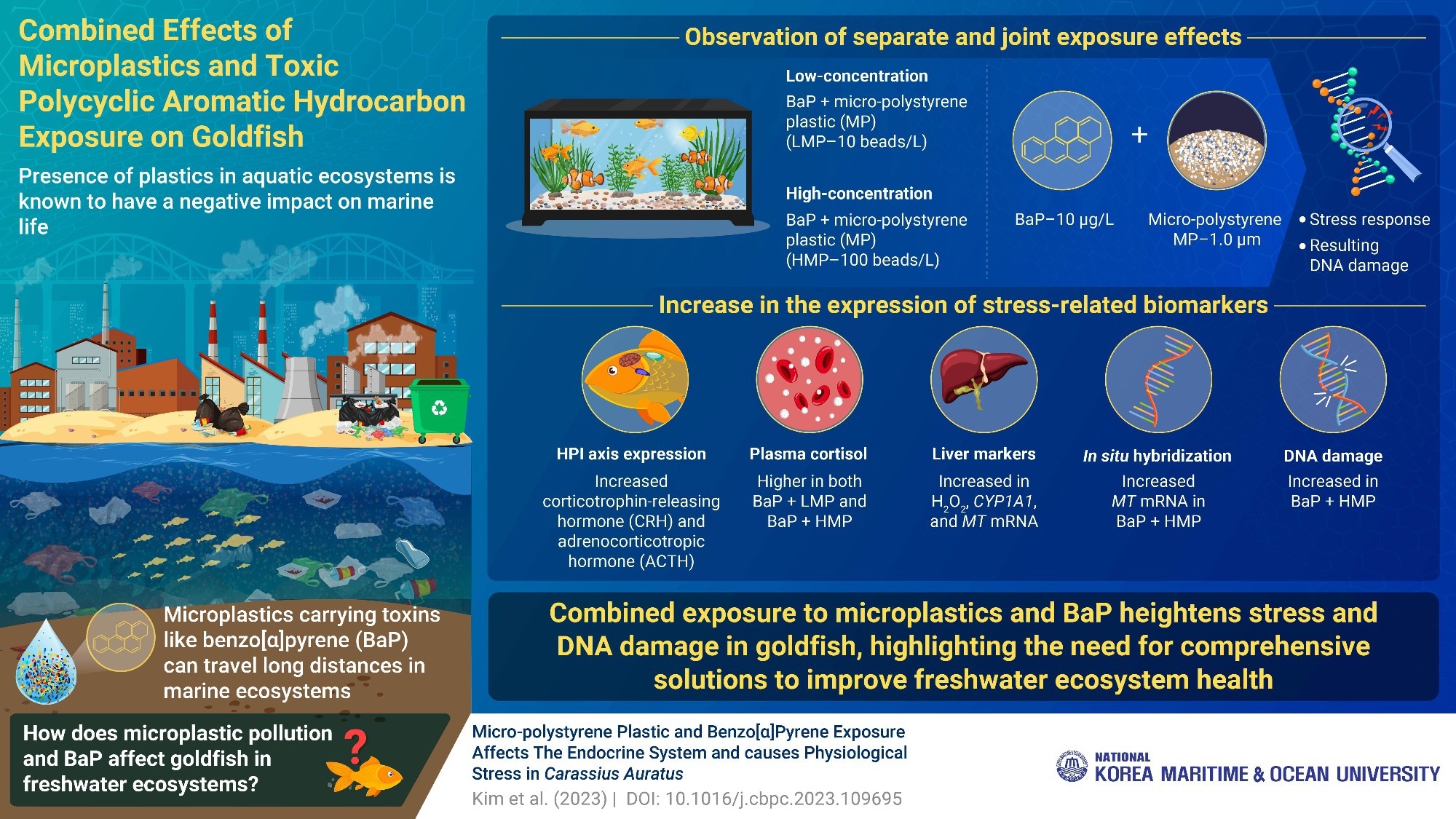Microplastic particles can travel long distances in oceans and are known to carry with them harmful and persistent organic pollutants like benzo[α]pyrene (BaP), a polycyclic aromatic hydrocarbon. Now, scientists from Korea have studied the individual and synergistic impact of microplastic and BaP exposure on Carassius auratus, a type of goldfish found in freshwater ecosystems. Their findings reveal heightened stress responses, increased DNA damage, and liver abnormalities in goldfish, highlighting a serious consequence of environmental pollution.
 Microplastics can act as carriers of toxic chemicals such as benzo[a]pyrene (BaP) as they travel long distances in aquatic environments. These pollutants can have detrimental effects on wildlife, including disrupted stress response, bioaccumulation, and carcinogenicity. When marine life is exposed to both microplastics and toxic chemicals like BaP, these negative effects are significantly amplified, leading to more severe impacts on the health of aquatic organisms. Image credit: Cheol Young Choi from Korea Maritime and Ocean University
Microplastics can act as carriers of toxic chemicals such as benzo[a]pyrene (BaP) as they travel long distances in aquatic environments. These pollutants can have detrimental effects on wildlife, including disrupted stress response, bioaccumulation, and carcinogenicity. When marine life is exposed to both microplastics and toxic chemicals like BaP, these negative effects are significantly amplified, leading to more severe impacts on the health of aquatic organisms. Image credit: Cheol Young Choi from Korea Maritime and Ocean University
The presence of plastics in our oceans and waterbodies is one of the most significant threats to marine ecosystems. In 2022, plastic production exceeded 400 million tons globally, and this number continues to rise. The presence of microplastics, ranging in size from 100 nanometers to 5 millimeters, is particularly concerning. Owing to their small size, they can travel long distances in the oceans and can easily be ingested by a wide range of marine organisms, resulting in their accumulation in the food chain. Another aspect of microplastic pollution, often overlooked but equally dangerous, is their ability to absorb and carry harmful chemicals, such as persistent organic pollutants.
Benzo[α]pyrene (BaP) classified as a polycyclic aromatic hydrocarbon, stands out as a pollutant with significant concern. Produced as a byproduct of fuel and combustion processes, previous studies have reported BaP to be responsible for the induction of physiological stress and DNA damage in fish and other marine organisms. Moreover, its slow degrading ability and carcinogenicity adds to its worrisome nature. On being carried along with microplastics, which tend to act as carriers of pollutants owing to their hydrophobic surfaces, their accumulation in aquatic ecosystems can lead to enhanced toxicity in organisms who absorb these chemical substances. Understanding the extent of toxicity and threat posed by the combined impact of exposure to microplastics and other pollutants is, therefore, important.
In a recent study now, researchers led by Dr. Cheol Young Choi from National Korea Maritime and Ocean University explored the impact of microplastic and BaP exposure on freshwater goldfish (Carassius auratus), who were exposed to BaP and microplastics individually and in combination, to understand their exposure effects. Their findings, made available online on June 30, 2023 and published in Volume 271 of Comparative Biochemistry and Physiology Part C: Toxicology & Pharmacology in September 2023, focused on the goldfish’s stress response, including stress-related genes, cortisol levels, and DNA damage.
Elaborating further on their study, Dr. Choi explains, “When faced with harmful pollutants, organisms undergo a stress response for survival. In fish, we witness this through the activation of their stress regulating axis, the hypothalamus–pituitary–interrenal axis, and the release of hormones like cortisol. While this response is essential for short-term survival, prolonged stress can disrupt the overall health of the organism.”
The experimentation revealed that in addition to affecting the endocrine system, exposure to pollutants can also result in damage to the organism’s DNA. Both BaP and microplastics, when encountered separately, triggered abnormal effects in the goldfish. However, on being exposed to both substances together, the goldfish experienced a stronger effect—more stress and DNA damage was observed compared to either substance alone. “This is concerning, because it shows that everyday pollutants, often found together in natural environments, can interact in particularly harmful ways, amplifying the negative effects they have on wildlife,” says Dr. Choi, explaining the findings. The concentration of these pollutants in our aquatic ecosystems is indeed worrying, and they not only affect aquatic life but also have potential implications for human health.
Going ahead, comprehensively understanding the compound effects of toxins on being combined, beyond their already harmful individual impacts, is essential for developing more effective and targeted strategies to deal with this multifaceted problem. While the chemical effects of microplastics on marine life had been relatively understudied compared to other pollutants like BaP, this study brings to light new evidence that emphasizes the importance of considering their combined effects with other pollutants.